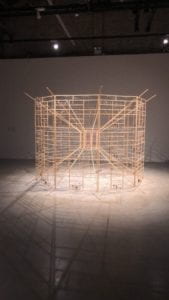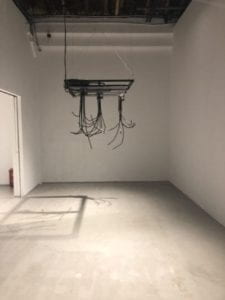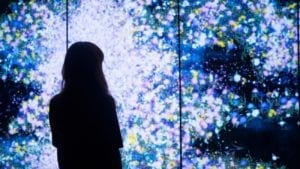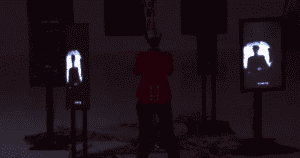A:
Prior to taking Interaction Lab, I had never seen anything like the Chronus exhibition. The aspect of the exhibition that stuck out to me the most was the simplicity behind some of the art pieces. To be honest, I have always felt that we were limited by the small selection of hardware in our Arduino kits, however seeing the Chronus exhibition changed my mind. There was one piece in particular that ran consisted of an Arduino controlling an array of servo motors. The piece of art utilized these servo motors to pull yarn in such a fashion that it generated a complex and “animated” geometric shape. Seeing such a beautiful display consisting of components all found in my Arduino kit really altered my perspective on our limitations; I now believe that our only limitation is our imagination. While the Chronus exhibition was certainly different from other non-technology art exhibits I’ve visited in the past, there were some key similarities. The strongest example of a similarity between the two is symbolism. While the art, both tech and non-tech based, is entertaining to look at because, there is always hidden meaning. How the artist chooses to convey that is their choice, but this is a practice among both tech and non-tech based art exhibitions. Seeing these really inspired me to emulate this kind of hidden meaning mentality in my project. The main difference between tech and non-tech art exhibitions are the mediums used. The Chronus exhibition made me realize that tech-based art exhibitions have far more potential in the variety they can produce. Couple that with the subtle whirring of these projects in action, and you create an environment that a non-tech based art exhibit could never create.


B:
Flowers and People – Dark
Flowers and People – Dark is a project that I find to be a particularly interactive. Flowers and People – Dark created vibrant floral images for the user that stand before them. The image itself is influenced by a variety of factors that are not disclosed which creates a sense of exploration for the user in the sense that they can learn how to control the images they create. The project is influences solely by the users and will never replicate the same visual state twice. I respect this aspect of the project because the user will have a different experience each time they go through it. Moreover, once the user backs away from the installation the flowers will simultaneously wither and die. This is to convey the installations hidden representation of the cycle of life. This project creates a unique relationship with every user and does uses this relationship to ponder the complexities of life and death. A nice touch is that it does this in an utterly beautiful LED display. It is for these reasons that I find the project to be a strong example of an interactive experience.

Emergence
Emergence is a very interesting concept and puts on a beautiful show, however it is not as interactive as the aforementioned project. Emergence takes the users biorhythms and transforms them into a sound and light show. While this is extremely entertaining to look at, one must take into account how much the user really does in this instance. All the user does is simply attach themselves to a couple of sensors and experiences the show. In reality the only interaction that occurs is attaching some wires to yourself. While every user will most likely have a unique experience, they do not really have control in how that experience plays out. While the show is beautiful and the technology is awesome, this installation is not as up to par on an interactive level.

C:
This research has helped me to build upon what I find interaction to be. I strongly resonated with Chris Crawford’s definition of interactivity in which he says interaction is: “a cyclic process in which two actors alternately listen, think, and speak”. This definition applies greatly to Interaction Lab projects because they primarily generate an experience of which the user applies inputs and the project will provide a special output. What I love about this definition is this concept of fluidity. This definition appears to frame interaction as a type of conversation. Conversations never go the same way, this is why the more influence a user has over the outputs a project can produce, the more interactive it is. moreover, the idea of a project listening to its user is very straight forward, however how does a user listen to the project? This comes in the form of the hidden meaning preciously discussed. If the project can get the user to reflect on some underlying message, then that is how the user listens to the project. Ultimately, the user should be able to leave the experience having influenced a project to influence them in some sort of way; this is the key to good interaction.
Works Cited:
https://www.teamlab.art/w/flowersandpeople-dark
https://www.trendhunter.com/trends/sean-montgomery-emergence
What Exactly is Interactivity? – Chris Crawford